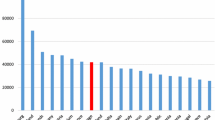Abstract
A model of Ukrainian shadow economy moneydemand is estimated that includes newregulatory burden, tax complexity, andsoft-budget constraint variables. Thismodel is analyzed to determine the causesand dynamics of the Ukrainian shadoweconomy and to assess the effectiveness ofstate measures undertaken to reduce itssize. The direct tax burden, thebroadly defined regulatory burden, thecomplexity of the tax system, andsoft-budget constraints for enterprises are found tobe important causes of unofficial activity.The main explanatory factors forthe estimated decline of the shadow economyin recent years are explained and it is argued that theevidence has implications beyond the caseof Ukraine.
Similar content being viewed by others
References
Clotfelter, C.T. (1983). Tax evasion and tax rates: An analysis of individual returns. The Review of Economics and Statistics 65: 362-373.
Dobozi, I. and Pohl, G. (1996). Real output decline in transition economies - Forget GDP, try power consumption data. Transition Newsletter 6: 17-18, World Bank, Washington, D.C.
Feige, E.L. (1979). How big is the irregular economy? Challenge 22: 5-13.
Gregory, P. and Melota, I. (2001). New insights into Ukraine's shadow economy: Has it already been counted? Institute of Economic Research and Policy Consulting, Working Paper, Kiev, (forthcoming).
Guttmann, P.M. (1997). Subterranean economy. Financial Analysts Journal 33: 26-27.
Hill, R. and Kabir, M. (1996). Tax rates, the tax mix, and the growth of the underground economy in Canada: What can we infer? Canadian Tax Journal 44: 1552-1583.
International Finance Corporation (1999). The state of small businesses in Ukraine. An IFC survey of Ukrainian small businesses in Makeyevka, Mykolayiv, Kirovograd, Chernigiv, and Rivne, Kiev, May.
International Finance Corporation (2001a). Note on inspections of enterprises. Review of data obtained from different surveys in 1997-1999, Kiev, March, unpublished.
International Finance Corporation (2001b). Ukrainian enterprises in 2000. An IFC survey of Ukrainian businesses, Kiev, May.
Johnson, S., Kaufmann, D. and Shleifer, A. (1997). The unofficial economy in transition.Brookings Papers on Economic Activity 2: 159-239.
Johnson, S., Kaufmann, D. and Zoido-Lobodan, P. (1998). Regulatory discretion and the unofficial economy. American Economic Review, Papers and Proceedings, May: 387-392.
Kaufmann, D. and Kaliberda, A. (1996). Integrating the unofficial economy into the dynamics of post-socialist economies: A framework of analysis and evidence. Policy Research Working Paper No. 1691, World Bank, December.
Klovland, J. (1984). Tax evasion and the demand for currency in Norway and Sweden. Is there a hidden relationship? Scandinavian Journal of Economics 86: 423-439.
Lacko, M. (2000). Hidden economy - an unknown quantity? Comparative analysis of hidden economies in transition countries, 1989-95. Economics of Transition 8: 117-149.
Management Systems International, Development Alternatives Incorporated, Kiev International Institute of Sociology (2000). Small and medium enterprises baseline survey, Kiev.
Schneider, F. and Enste, D. (2000). Shadow economies: Size, causes, and consequences.Journal of Economic Literature 38: 74-114.
Schneider, F. and Neck, R. (1993). Shadow economy under changing tax systems and structures. Finanzarchiv 50: 344-368.
Shabsigh, G. (1995). The underground economy: Estimation, and economic and policy implications: The case of Pakistan. International Monetary Fund, Working Paper.
Tanzi, V. (1983). The underground economy in the United States: Annual estimates, 1930-80.International Monetary Fund Staff Papers 30: 283-305.
Thie ßen, U. (2001) Presumptive taxation for small enterprises in Ukraine. Institute of Economic Research and Policy Consulting, Working Paper No. 6, Kiev, March.
Wagner, R.E. (1976). Revenue structure, fiscal illusion and budgetary choice. Public Choice 25: 45-61.
Weck-Hannemann, H., Pommerehne, W. and Kirchgässner, G. (1988). Abgabenpolitische Ideen zur Eindämmung der Schattenwirtschaft (Ideas concerning tax policies in order to reduce the shadow economy). In: H. Scherf (Ed.), Beschäftigungsprobleme hochentwickelter Volkswirtschaften, 343-357. Jahrestagung des Vereins für Socialpolitik. Gesellschaft für Wirtschafts-und Sozialwissenschaften in Berlin 1987, Berlin.
Rights and permissions
About this article
Cite this article
Thießen, U. The Impact of Fiscal Policy and Deregulation on Shadow Economies in Transition Countries: The Case of Ukraine. Public Choice 114, 295–318 (2003). https://doi.org/10.1023/A:1022624619203
Issue Date:
DOI: https://doi.org/10.1023/A:1022624619203




